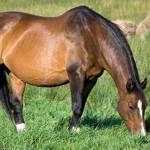By the Numbers: Important Broodmare Facts and Figures

Whether you are just starting to plan your mare’s next foal or if you are in the thick of foaling season, make sure you know the most important milestones, facts, and stats when counting the days until your healthy foal arrives.
1: The number of live foals desired from a mare in a given year. Your mare should have an ultrasound exam approximately 14 days after breeding to ensure there is only one embryo present.
3: There are three phases of gestation (early, mid, and late), and three stages of foaling. Become familiar with each of these and the key health and nutritional aspects of each phase and stage (spoiler alert: the foal is born during the second stage of foaling).
6: Overweight mares have lower fertility, decreased milk production, and potentially an increased risk of dystocia. Plus, they are at risk for insulin resistance and laminitis. Mares should not be maintained at a body condition score above 6.
8: Colostrum, the mare’s first milk, provides foals with infection-fighting antibodies. Good-quality colostrum should contain at least 8 g of protein (primarily protein called immunoglobulin G or IgG) to avoid failure of passive transfer and associated immunity problems.
16: In the Northern Hemisphere, many broodmares require exposure to 16 hours of light to advance the breeding season. Consider the pros and cons of a 100-watt light bulb versus a Blue Light Mask when preparing your mare for the upcoming breeding season.
50: Early embryonic death, loss of the fetus before 50 days gestation, is the leading cause of pregnancy loss in horses. Approximately one-fifth of mares will abort during this time. Have your mare preg-checked throughout early gestation to identify fetal loss and to plan rebreeding.
24: Both the newborn and the mare need to be examined by a veterinarian within the first 24 hours of parturition. This will facilitate identification of sick foals and mares (e.g., failure of passive transfer in the foal, retained placenta in the mare) and expedite treatment.
75: Three-quarters of a foal’s growth occurs during the last third of pregnancy. This means that for the bulk of her pregnancy, the mare should not be adding weight due to excess feed. In most mares, additional concentrate designed to provide extra energy is only needed as the third trimester draws close.
245: Near the start of the third trimester of pregnancy, the seventh month or 245th day of gestation, mares should no longer be offered tall fescue to avoid the undesirable effects of this forage, referred to as fescue toxicosis.
335-340: If your mare is “average,” then now is the time! Be ready for your foal’s arrival, bearing in mind that most of the time parturition goes smoothly, but not always. Have a backup plan for colostrum and your veterinarian’s number at the ready just in case.
“Nutrition of the mare not only impacts her health but also the health of her foal. Inappropriate nutrition—too many calories to cause obesity, too few calories to produce ribbiness, or underfortification of essential nutrients—can have lifelong effects on foal health and athleticism,” reminded Kathleen Crandell, Ph.D., an equine nutritionist for Kentucky Equine Research.
In addition to diet staples such as forage, concentrate, and ration balancers, certain supplements have proven effective in managing broodmares, including a source of omega-3 fatty acids. Studies have shown improved fertility, enhanced colostrum quality, and increased passive transfer of antibodies. Fish oils are direct sources of the most biological active omega-3 fatty acids, docosahexaenoic acid (DHA) and eicosapentaenoic acid (EPA), so it is important to choose a supplement, such as EO-3 from Kentucky Equine Research, derived from a marine source.








